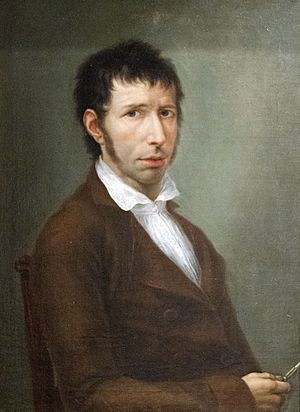Ramón Bayeu facts for kids
Ramón Bayeu y Subías (born December 2, 1744, in Zaragoza – died March 1, 1793, in Aranjuez) was a Spanish painter. He is mostly known for designing pictures for tapestries. Tapestries are woven artworks, like large, detailed cloths, often used to decorate walls. Ramón Bayeu was part of the Neoclassicist art movement, which focused on clear, simple styles inspired by ancient Greek and Roman art.
Contents
Early Life and Training
Ramón's father made surgical tools and barbers' tools. Ramón had two brothers who were also painters: Francisco Bayeu and Manuel Bayeu. In 1758, his brother Francisco received a special scholarship to study art in Madrid. Ramón and his brothers went with him because they had lost their parents.
Francisco was asked to leave the art school in 1759. So, Ramón went back to Zaragoza with him. Ramón then became Francisco's first student, learning to paint from his older brother.
In 1763, Francisco got a job at the Royal Tapestry Factory from King Charles III. Ramón went back to Madrid and joined the Real Academia de Bellas Artes de San Fernando, a famous art school. In 1766, he earned a scholarship to study art in Italy.
Working as an Artist
After 1773, Ramón started painting designs for the Royal Tapestry Factory. These designs were called "cartones" (cartoons). They were large paintings used as guides for weavers to create tapestries. He made 35 of these designs in total. Many of his designs became very popular and were copied often.
Ramón also worked with his brother-in-law, the famous painter Francisco Goya. They worked together on art projects in different places. These included the Royal Monastery in Valladolid and the Church of Our Lady of the Assumption in Valdemoro. Ramón also painted several large wall paintings, called frescoes, in the Basilica of Our Lady of the Pillar in Zaragoza.
Career at the Royal Tapestry Factory
Ramón worked as an assistant director at the Royal Tapestry Factory starting in 1765. In 1776, he tried to get the title of "Painter to the King." He didn't get the title, but he did receive a good yearly payment. He tried again in 1778 but was still not successful.
In 1780, the factory had to stop working for a while because it ran out of money. Ramón then worked as a traveling painter for five years. In 1786, his brother Francisco and another artist, Mariano Salvador Maella, asked for Ramón to be made Director of the factory. He got the job and stayed in that position until he died.
He tried to become a "court painter" in 1788, which meant he would paint for the royal family. This attempt was also not successful. In 1791, he didn't want to paint any more tapestry designs. He preferred to paint religious artworks and portraits. However, he was told his salary would be stopped if he refused. As a compromise, he was also made a court painter, but without extra pay.
Later Life and Death
In 1792, Ramón started showing serious signs of lead poisoning. He had gotten sick years before from chemicals in his paints while working on his own. Even after resting, he continued to get worse.
He died the next year, in 1793, while he was in Aranjuez. He was working on a project for the King at the time. Ramón Bayeu never married and did not have any children.
Many of his engravings are copies of famous paintings. One example is Liberation of St. Peter by Guercino. This artwork is now in the Museo del Prado, a famous museum in Spain. The museum also keeps some of Ramón's original tapestry designs.
See also
 In Spanish: Ramón Bayeu para niños
In Spanish: Ramón Bayeu para niños



